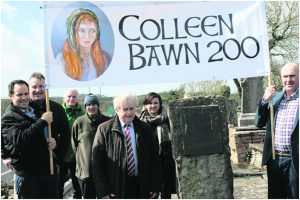
Various bodies from West Limerick and Clare are encouraging businesses in the Shannon Estuary to promote tourism and enticed visitors to come and visit the Shannon region. As part of this promotion businesses and coordinators from these bodies visited key tourist attractions on the Shannon Estuary where one of the highlights of the day was a visit to Barrane Cemetery in Killimer in County Clare where the Colleen Bawn is buried. This year is the 200th year of the tragic murder of Ellen Hanley, the Colleen Bawn, which took place on the River Shannon in June 1819. It was one of the most documented and publicised murders which took place 200 years ago.
A form of marriage took place between John Scanlon and Ellen Hanley. The intending husband wanted the marriage to be kept secret. Following the marriage it is believe that it was a false marriage which was orchestrated by her supposedly new husband John Scanlon. John Scanlon lived at Ballyvcahane, Manister Croom and Ellen Hanley lived close by with her uncle John Hanley. John Scanlon and Ellen Hanley eloped and marriage took place. Scanlon soon grew tired of his new bride and it is documented that he decided to get rid of her by arranging for his servant O’Sullivan to take her out in his boat and murder her. The body washed ashore at Moneypoint near Kilrush, six weeks later following her disappearance, and evidence showed that she was murdered. A large-scale search was mounted for the culprit(s) and subsequently the Coroner’s Jury brought in a verdict of willful murder against John Scanlon and Stephen O’Sullivan in November 1819. Scanlon was arrested at his father’s castle and residence at Ballycahane, Manister, Croom. On 16th March 1820 the Honou-rable Richard Jebb, 4th Justice of the King’s Bench, convicted Scanlon of the murder of Ellen Hanley. The trial created great interest and Gerald Griffin correspondent with the Limerick Chronicle reported on the trial which created great interest throughout Ireland and many parts of the world. Scanlon was sentenced to death in the courthouse which was situated opposite St. Mary’s Cathe-dral in Limerick City and which is now across the way from the current Courthouse and City Council. It is documented that the horses that were to bring John Scanlon to his execution refused to cross the Shannon Bridge and many believed that this seemed to indicate that Scanlon was not the actual murderer, rather it was Stephen O’Sullivan, servant of Scanlon, who in actual fact committed the murder. Scanlon was executed at Gallowe’s Green situated at Clare Street, Limerick.Ellen Hanley was buried at Barrane Graveyard near Moneypoint where her body was found.
A resident of the area Peadar O’Connell, a school master and an Irish language writer, allowed Eileen Hanley’s body to be interred in his family grave. Many have visited the grave over the centuries and have chipped the head stone slab and have taken away parts of the stone slab as a memento.The tragedy of the Colleen Bawn has become a fascinating and sad story. Gerald Griffin who wrote the Collegians and the opera “The Lily of Killarney” which depicts and has made famous the sad ending of the Colleen Bawn. The staging of “Limerick Grand Carnival” which was held in 1896 and 1903 was undertaken to fundraise to help build St. John’s Convent and St. John’s Hospital. The Colleen Bawn Festival which took place in Croom during the 70’s and 80’s took place to fundraise for the purchase and development of Croom GAA field and complex.
Furthermore, the staging of the Colleen Bawn plays in London and in New York were recognised worldwide and highlight the audience that the story of the Coleen Bawn has attracted down through the years. The recent event by local tourism bodies along the Shannon Estuary had the story of the Colleen Bawn as a central part of the day and they are seeking to establish the Shannon Estuary Way as a major tourism attraction for visitors coming to the west coast of Ireland to come and visit. The establishment of this West Limerick Tourism network and the promotion of attracting tourists to the Clare side of the Shannon Estuary is seen as a key part of preparation in the development of businesses and tourism and they are now in the process of creating a strong network of visitors to the Shannon Estuary region.





